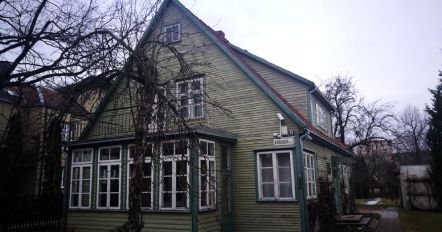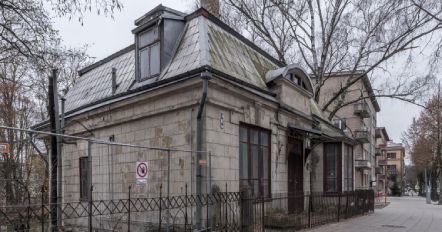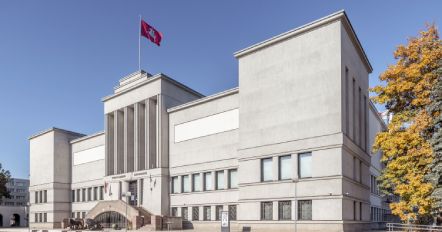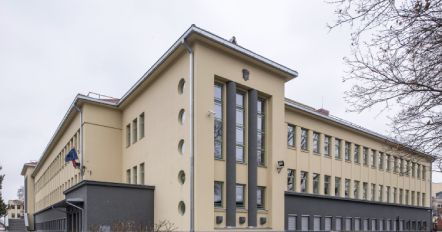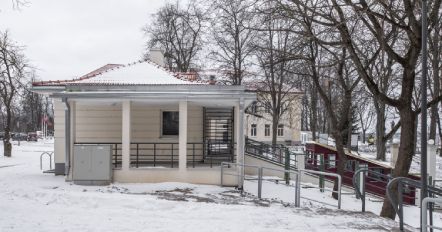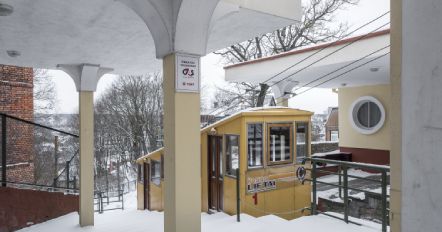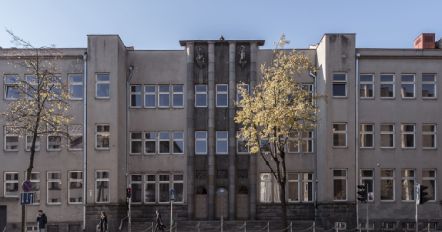Location
2019 February 5
A house, which was owned by the writer Balys Sruoga (1896–1947) and where he and his wife lived from 1938 to 1940 and in 1947. Current – Balys and Vanda Sruogos House-Museum which was opened in 1966. The exhibitions on display reflects the story of Sruogos’ family life and work.
2019 February 5
In this house two famous Lithuanian painters Domicelė and Petras Tarabildos lived.
2019 February 5
This huge and monumental building was a Žaliakalnis jewel. Grandeur was evoked by the broad steps leading to the school from the street. The school`s architectural image is akin to classicism. The building consists of four blocks: the main long one along the street and three wings adjoining on the yard side. The central one has the halls: on the first floor there is the sports hall with showers; the second floor contains the festive hall; and on the third there is a huge space for drafting. The side blocks have various teaching and learning rooms. About 700 students could have studied in the school at any given time: the school educated, among others, construction technicians and had an architectural division.
2019 February 5
This building represents, in the best and most clear way, the specific character of our interwar architecture: the harmonious interaction between tradition and modernity. Academic traditions are reflected by the way spaces and plan are structured to emphasize compositional axes and symmetry. This principle is opposed by the bell tower joined on the side through an arch gallery. The contradictory purpose of the museums – war and culture in one "body" – is expressed in two distinctly treated facades: the official, main one of the War Museum and the more laid-back one of the Culture Museum. In front of the War Museum there is a memorial square with monuments honoring famous activists and events of the national independence period.
2019 February 5
The construction of the gymnasium started in the summer of 1937 and was completed in September of 1938. The newspapers of that time wrote that the residents of the Lower Šančiai did not like the location of the school, which was in Upper Šančiai: "<...> because their children will have to climb a hill every day". However the gymnasium had 16 classes and 600 students. It was one of the largest and best equipped schools in Lithuania at that time. The architecture reflects the characteristic tendencies of the school – the functionality and the receptive moderation of forms.
2019 February 4
Aleksotas Funicular was constructed on the right bank of the Nemunas River was officially opened on 6 December 1935. Authentic traction equipment, including the genuine pre-war wagons, wooden seats, and stop platforms of the funicular are still used.
2019 February 4
Žaliakalnis Funicular is a funicular railway in Kaunas. Built in 1931, it is the oldest funicular in Lithuania and is among the oldest vehicles of such type in the world still operational.
2019 February 4
One of the earliest examples of a functionalist aesthetics in Kaunas, this building has a particularly laconic exterior of severe geometricized forms, with a clear delineation of spaces and planes and a distinct rhythm of elements. The kernel of the complicated plan is constituted by original oval-shaped halls. The purpose of the building was manifold: the first and third storeys had two five-room apartments; the second contained not only the owner`s apartment, but private suites in which he practiced internal medicine and Dr. Girša Elkes practiced ophthalmology. In one of the rented apartments the first Montessori kindergarten in Lithuania was established; from 1936 to 1940 the building also housed the Finnish consulate.
2019 February 4
The building is represented by the highly decorated central part. Below, above the arched entry spaces, there are thematic reliefs: Motherhood, New Settlers, and Horn of Plenty (sculpted by Juozas Zikaras).

